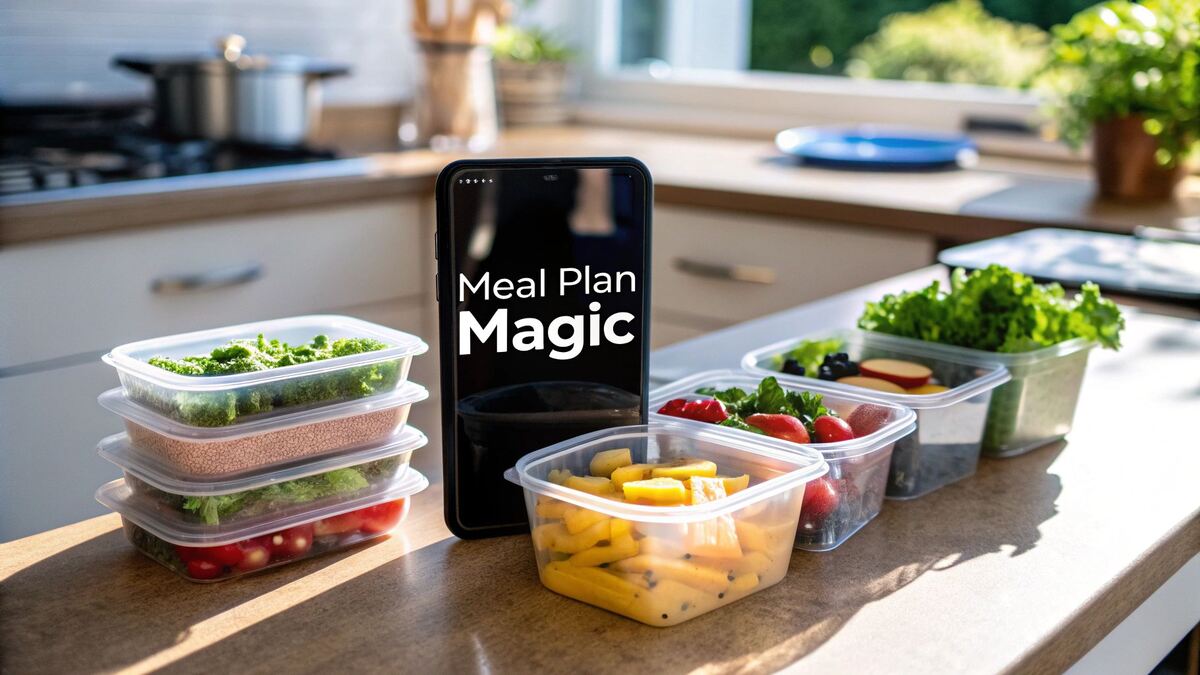How to Meal Plan for Weight Loss A Practical Guide
At its core, losing weight with a meal plan boils down to one simple concept: you need to burn more calories than you eat. It’s all about creating a sustainable caloric deficit through smart food choices, not by starving yourself on some crash diet.
Laying the Groundwork for Weight Loss That Lasts
Before you even think about recipes, you have to get the foundation right. A successful weight loss plan isn't a generic, one-size-fits-all 1,200-calorie diet you grabbed off the internet. It’s a strategy built around your body and your life. We're aiming for lasting habits, not a restrictive plan that's destined to fail.
The first step is figuring out your personal energy needs. While generic calculators are out there, they often miss the mark by ignoring your specific lifestyle and body composition. A great starting point is to calculate your BMI using our simple tool to get a solid baseline. Knowing this number helps you set realistic, achievable goals from day one.
Getting Your Macros Right
Once you have a calorie target in mind, the conversation shifts to the quality of those calories. This is where your macronutrients—protein, carbs, and fats—enter the picture. Getting the balance right is your secret weapon against nagging cravings and those dreaded afternoon energy crashes.
- Protein: This is your satiety powerhouse. It keeps you feeling full and satisfied, which naturally helps you eat less. Think lean chicken, fish, eggs, beans, and Greek yogurt.
- Carbohydrates: Don't fear the carbs! They are the primary fuel for your body and brain. Just be smart about it and stick to complex sources like oats, quinoa, sweet potatoes, and plenty of veggies.
- Fats: Healthy fats are crucial for hormone production and absorbing key nutrients. Good sources include avocado, nuts, seeds, and olive oil.
A well-balanced plate is so much more than just hitting a calorie number. It's about giving your body the high-quality fuel it needs to thrive, even in a deficit. This turns the whole process from a "diet" into a genuine lifestyle upgrade.
This personalized approach is a huge reason the global weight loss market is projected to hit an incredible $590.13 billion by 2033. People are moving away from generic diets and toward customized solutions, like AI-driven apps and wearables that build plans around their unique data. You can see the full breakdown of this trend in this detailed forecast.
Finding a Meal Planning Style That Fits Your Life
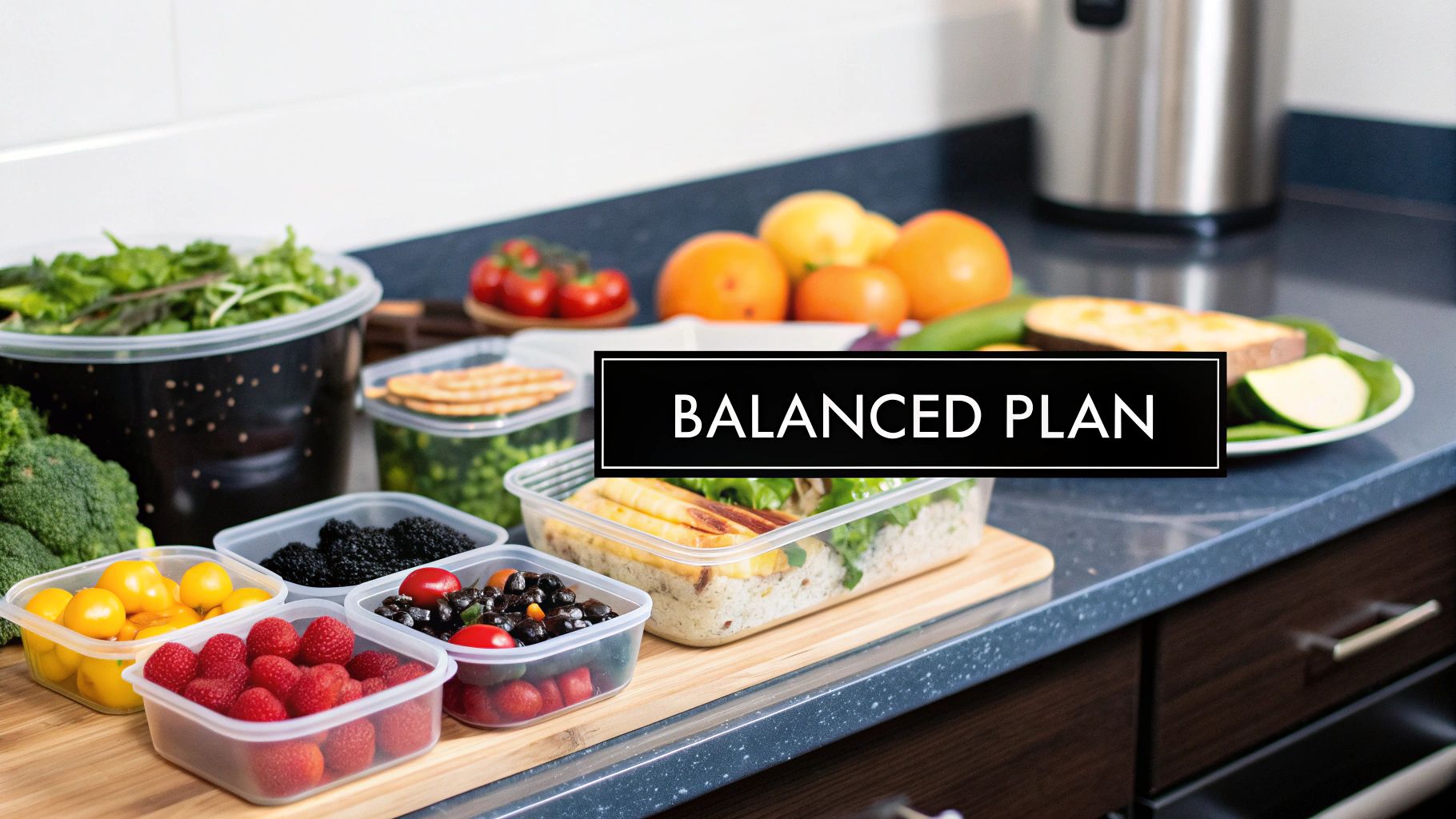
Let's get one thing straight: the secret to a weight-loss meal plan that actually works isn't about finding the "perfect" diet. It’s about finding an eating style that feels natural and sustainable for you. Forcing yourself into a super-restrictive plan is just a recipe for burnout.
The real goal is to borrow principles from proven food philosophies that click with your personal tastes and daily routine. Think of it less like following a rigid rulebook and more like creating a custom playlist—you pick what you like and leave the rest. This kind of flexibility is what builds habits that stick.
For example, the Mediterranean diet consistently tops the charts for both weight loss and overall health, and a big reason why is that people genuinely enjoy it and can stick with it long-term. It's built around whole foods, healthy fats, and lean proteins without making you feel deprived. As you can see in these expert diet rankings, sustainability is a huge factor.
Choosing Your Core Philosophy
So, where do you start? Different eating styles offer different roadmaps. The trick is to find one that doesn’t feel like you’re constantly fighting your cravings or your schedule.
To give you a better idea, I've broken down a few popular approaches. Think about which one sounds the most appealing and realistic for your life right now.
Comparison of Popular Weight Loss Diet Philosophies
| Dietary Approach | Core Principle | Best For | Potential Challenge |
|---|---|---|---|
| Mediterranean | Focus on whole foods: veggies, fruits, olive oil, fish, and whole grains. | Individuals looking for a flexible, heart-healthy lifestyle rather than a strict diet. | Can be higher in calories if portion sizes of healthy fats aren't monitored. |
| Lower-Carb | Reduce refined carbs (bread, pasta, sugar) in favor of protein, healthy fats, and non-starchy veggies. | People who want to manage blood sugar and find that carbs trigger cravings. | May feel restrictive initially and requires careful planning to get enough fiber. |
| Plant-Focused | Make plants the star of the plate, with or without small amounts of animal products. | Anyone wanting to increase fiber and nutrient intake while naturally lowering calorie density. | Requires conscious effort to ensure adequate protein and certain nutrients like B12. |
| Intermittent Fasting | Cycle between periods of eating and fasting, focusing on when you eat, not just what. | Those who prefer fewer, larger meals and don't like snacking throughout the day. | Can be difficult to manage with certain social situations or demanding schedules. |
Ultimately, these aren't rigid boxes you have to fit into. The best approach is often a blend. You might love the food choices of a Mediterranean diet but find that a lower-carb approach helps you feel your best. Mix and match!
The best meal planning style for weight loss is the one you can see yourself following a year from now. Consistency trumps intensity every single time.
Making It Work in the Real World
Let's put this into practice. Imagine a busy professional who knows that prepping five intricate meals every Sunday is just not going to happen.
Instead of giving up, they could adopt Mediterranean principles by stocking their fridge with hummus, pre-cut veggies, grilled chicken, and whole-grain pitas. This allows them to throw together quick, healthy lunches in minutes. They aren't following a strict "diet"—they're using a flexible, healthy framework that fits their life.
This is exactly why a balanced approach is so effective. For more ideas on putting this all together, take a look at our guide on creating a balanced meal plan for your lifestyle. Remember, your meal plan should reduce your stress, not add to it.
How to Build Your First Weekly Meal Plan
Alright, this is where the rubber meets the road. It's time to turn all those ideas into a real, actionable plan for your week. Don't stress about making your first meal plan perfect. The real goal is to create a simple, repeatable structure that takes the guesswork out of eating well.
I always tell my clients to start by brainstorming a "greatest hits" list of meals they actually like to eat. You're not going to stick with food you hate, right? Aim for five to seven ideas for breakfast, lunch, and dinner that fit your calorie targets. Maybe your breakfast list looks like this:
- Greek yogurt with a handful of berries
- Scrambled eggs with spinach and a slice of whole-wheat toast
- Oatmeal with a scoop of protein powder and peanut butter
When you have this core list, filling out a weekly schedule feels less like a chore and more like putting a simple puzzle together. It’s the ultimate defense against that 6 PM "what's for dinner?" panic that sends us straight to the takeout apps.
From Plan to Plate
Got your meal ideas? Great. Now, let's map them onto a calendar. You don't need a fancy app or spreadsheet—a simple grid with the days of the week is perfect. Just start plugging in your go-to meals, and try to rotate them to keep things from getting boring.
The best meal plan isn't the most complicated one—it's the one you'll actually follow. When it comes to building a sustainable habit, simplicity is your secret weapon.
This infographic breaks down the process beautifully, from planning your meals to hitting the grocery store without breaking the bank.
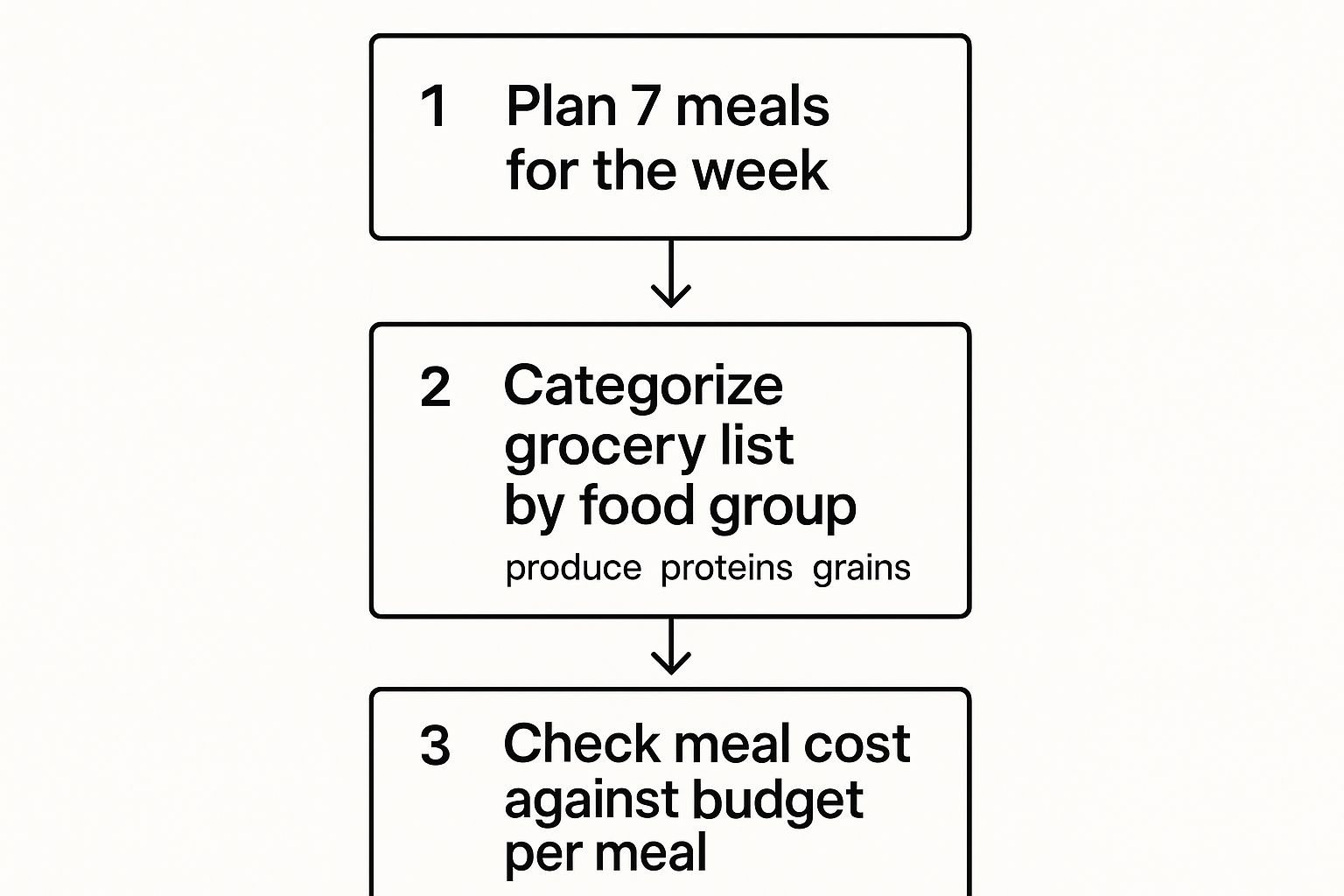
It’s a clear visual that shows how everything connects: your meal choices directly create a smart, budget-friendly shopping list. That's the core of successful planning.
With your weekly calendar filled out, your grocery list practically writes itself. Instead of aimlessly wandering the aisles, you'll have a clear mission. I find it helps to organize my list by store section (produce, protein, dairy, etc.) to make the trip super efficient. This focused approach saves time, reduces food waste, and helps you steer clear of those tempting, off-plan items that always seem to find their way into your cart. For a more precise approach, you can even use a recipe calorie calculator to dial in your portions and macros.
An Example in Action
Let’s put this into practice. Imagine someone is trying to lose 10 pounds. Their week could look something like this:
- Breakfast: Greek yogurt with berries on Monday, Wednesday, and Friday. Two scrambled eggs on Tuesday and Thursday.
- Lunch: A big salad with grilled chicken on Monday and Wednesday. Leftovers from the night before on Tuesday and Thursday.
- Dinner: They only need to plan three different dinners: Sheet Pan Lemon Herb Chicken with Veggies, Turkey Chili, and Salmon with Quinoa. They'll just cook a double batch of each to cover two nights.
See how simple that is? It’s got variety, it’s efficient, and it makes grocery shopping a breeze.
If you want an even faster start, you can use our tool to generate a personalized meal plan that’s built around your specific goals and food preferences.
Mastering Meal Prep Without the Monotony
A brilliant meal plan is one thing on paper, but it's useless if the food isn't ready to go when you are. This is where meal prepping becomes your secret weapon. It’s what turns your good intentions into real, healthy choices, especially on those hectic days when your time and willpower are running on empty.
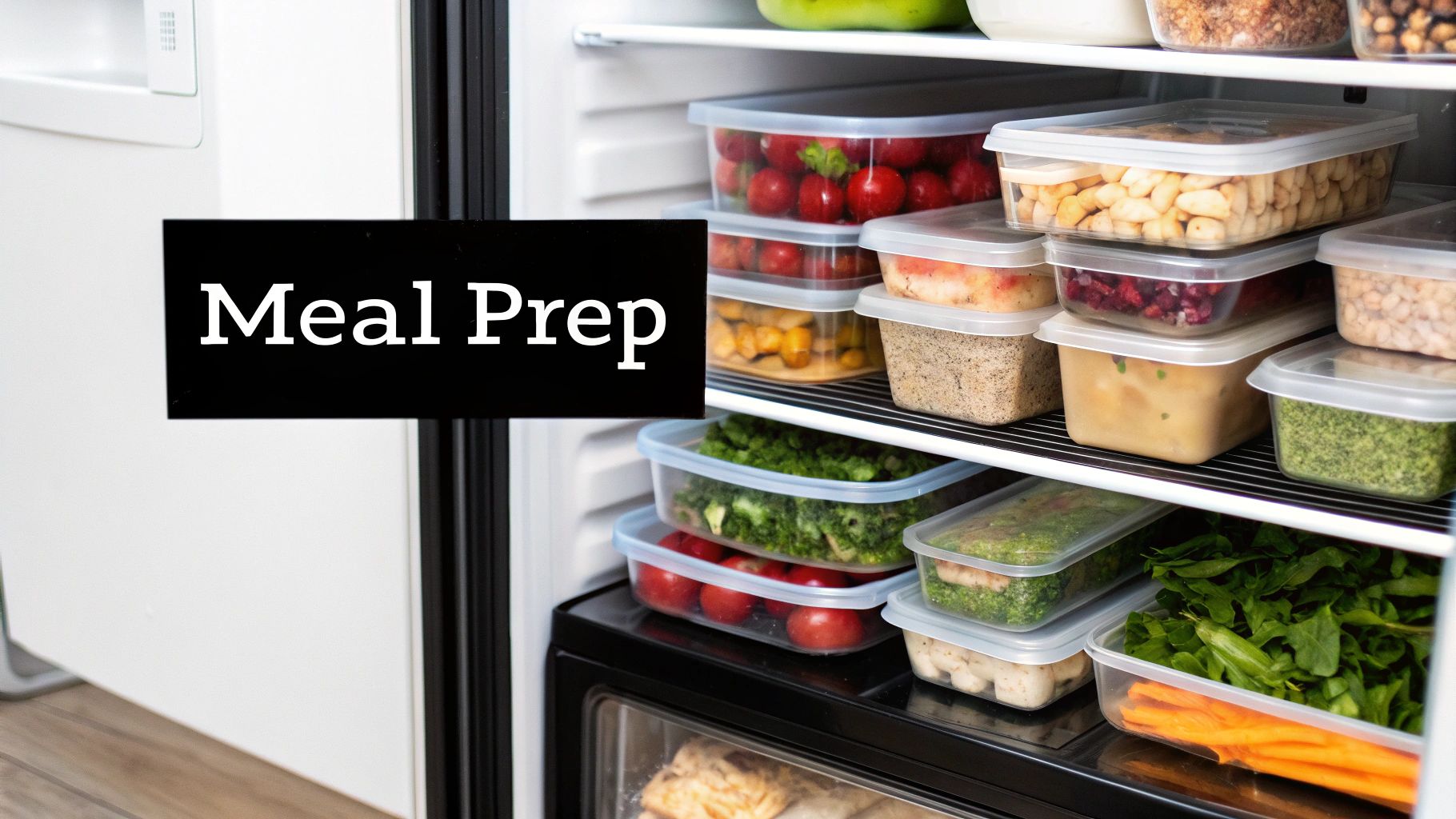
The key is finding a rhythm that actually works for your life. Forget the idea that you have to lose your entire Sunday to the kitchen. Some people love making complete, ready-to-eat meals, while others, like me, find more freedom in batch-prepping versatile ingredients.
Think about it: you could grill a big batch of chicken breasts, roast a colorful sheet pan of your favorite veggies, and cook up a pot of quinoa. These staples are your building blocks for the week. You can mix and match them on the fly to create completely different meals, which is the best defense against the dreaded meal-prep boredom.
Keeping It Fresh and Interesting
I hear it all the time: "I can't meal prep because I hate eating the same thing every day." Fair enough. But with a little creativity, those prepped ingredients can become something new and exciting each day.
Let’s take that batch of grilled chicken. It can be the star of three totally different lunches:
- Monday: Sliced chicken on a big bed of mixed greens with a light vinaigrette.
- Tuesday: Shredded chicken tucked into a whole-wheat wrap with a smear of hummus and a handful of spinach.
- Wednesday: Diced chicken tossed into a warm quinoa bowl with black beans, corn, and a spoonful of salsa.
See? This "component prep" approach saves you from staring at five identical, sad-looking containers. A quick tip: invest in a good set of airtight glass containers. They're fantastic for reheating and won't get stained or smelly like plastic often does.
The real point of meal prep isn't to create a rigid, boring menu. It's to make the healthy choice the easiest choice. When a nutritious meal is just as convenient as grabbing a bag of chips, you've already won half the battle.
Proper storage is also crucial for keeping your food safe and tasty. Most of your prepped meals will stay fresh for about 3-4 days in the fridge. If you're prepping for longer than that, make the freezer your best friend. Soups, chilis, and even cooked grains like rice and quinoa freeze wonderfully, giving you a backup for those extra-crazy weeks. This one habit can save you from the last-minute takeout orders that always seem to sabotage your progress.
Using Tech to Make Meal Planning Easier
Let's be honest: manually tracking calories, building shopping lists, and making sure you hit your macros can feel like a full-time job. Thankfully, we're long past the days of pen-and-paper food diaries. Today, there's a whole host of apps that can act as your personal nutrition assistant.
These tools aren't just glorified calorie counters. The best ones come loaded with features like barcode scanners for logging food in seconds, recipe suggestions that fit your specific tastes, and grocery lists that automatically populate from your meal plan. It’s all about making healthier choices feel like the path of least resistance.
Finding the Right App for You
With a sea of options out there, the key is to pinpoint what you struggle with most. Hate coming up with new dinner ideas? Look for an app with a massive, user-rated recipe library. Is tracking your biggest hurdle? Find one with a giant food database and a super-fast logging interface.
A few must-have features to look for include:
- Recipe Discovery: Lets you find meal plans that actually fit your dietary needs and what you like to eat.
- Automated Grocery Lists: Turns your entire weekly plan into a ready-to-go shopping list. This is a huge time-saver.
- Nutrition Tracking: Gives you a clear, at-a-glance view of your daily calories and macros.
- Barcode Scanning: Allows you to zap the code on any packaged food for instant logging. No more manual entry.
The best tool is the one you’ll actually stick with. Find an app that feels intuitive and motivating to you. If you enjoy using it, you're far more likely to build those lasting habits.
If you’re looking for a more dedicated tool, something like Gymkee's Nutrition Builder can seriously simplify the entire meal planning process from start to finish.
The numbers don't lie—people are leaning into technology for their health goals. Diet and nutrition apps have racked up over 200 million downloads, and a huge number of users report that these tools genuinely helped them improve their eating habits. This isn't just a fad; it's a real shift toward using smart tools for personalized wellness.
Got Questions About Meal Planning? Let’s Clear Things Up
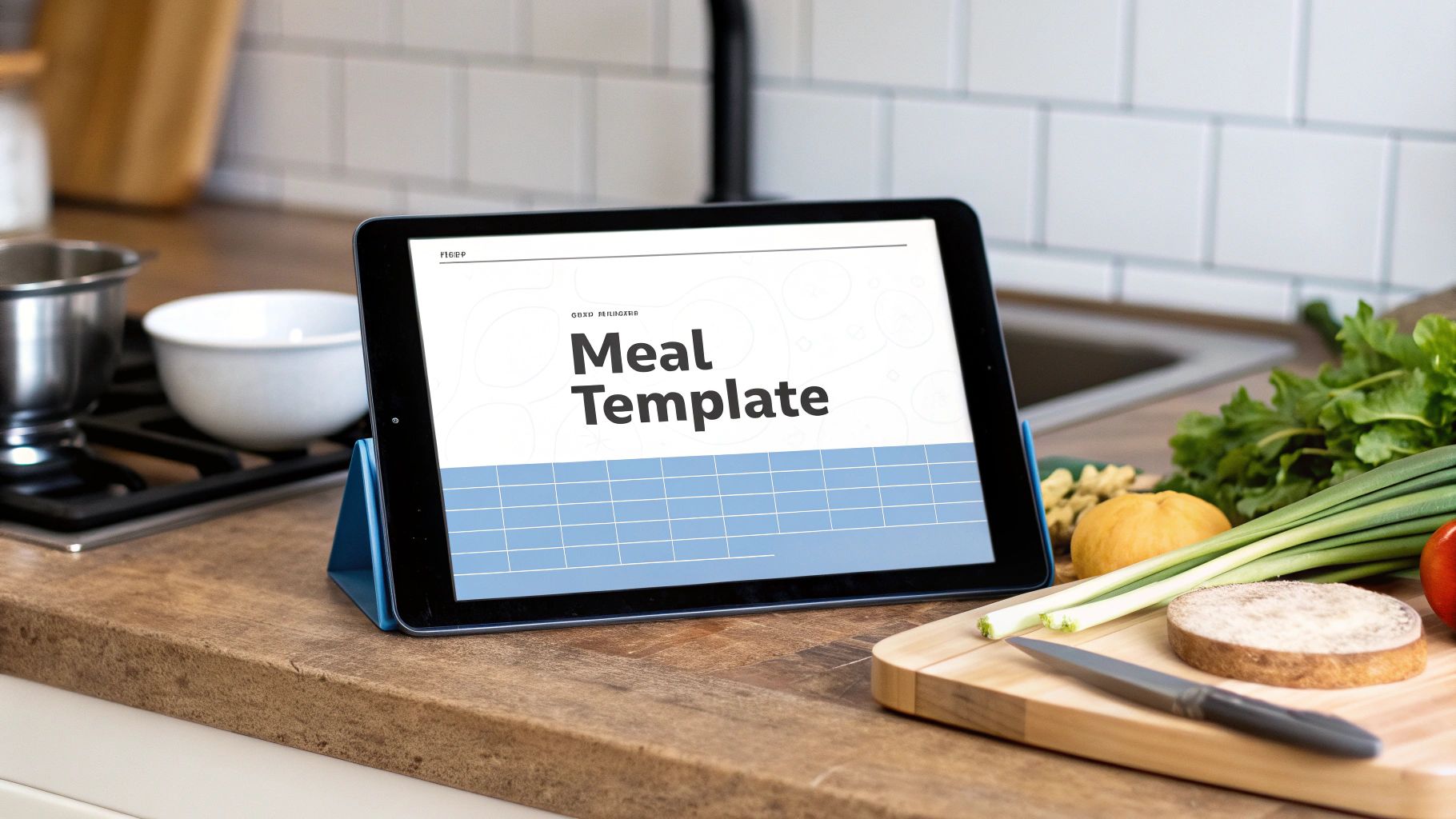
Jumping into meal planning always brings up a few common questions. Getting these sorted out from the start will make it much easier to build a plan you can actually stick with for the long haul.
So, How Many Meals Should I Be Eating Each Day?
Honestly, there’s no single right answer to this one. You’ll hear some people swear by three solid meals a day, while others feel better grazing on five or six smaller ones. What truly matters is hitting your total daily calorie goal, not how many times you sit down to eat.
The best advice I can give is to experiment a bit. See what schedule keeps you feeling full, energized, and in control. The "right" number of meals is simply the one that fits your life and stops you from raiding the pantry late at night.
What Happens When I Get Tired of the Same Meals?
Meal boredom is a real plan-killer. It’s probably the number one reason people fall off the wagon. The trick is to build in variety from the very beginning.
I always recommend having a go-to list of 10-15 favorite recipes for each meal. These are your staples. From there, try to introduce just one new recipe a week—nothing crazy, just enough to keep your taste buds interested.
A "mix-and-match" strategy is also a game-changer. For instance, if you grill a big batch of chicken on Sunday, you can use it for:
- A salad on Monday
- A whole-wheat wrap on Tuesday
- A stir-fry on Wednesday
This way, you get different meals without having to cook from scratch every single day.
A sustainable meal plan is never about restriction. It’s about creating a framework that includes foods you actually love. Forcing yourself to eat things you don't enjoy is a surefire way to burn out.
And remember, a successful plan has room for the foods you love. It’s all about moderation.
Ready to stop guessing and start building a meal plan that works for you? The AI Meal Planner creates personalized weekly menus based on your specific goals and dietary needs. Get your custom plan today!
AI-powered nutrition
Get Your Personalized Meal Plan
AI creates the perfect meals for your goals, lifestyle, and taste.
Start Your Journej
